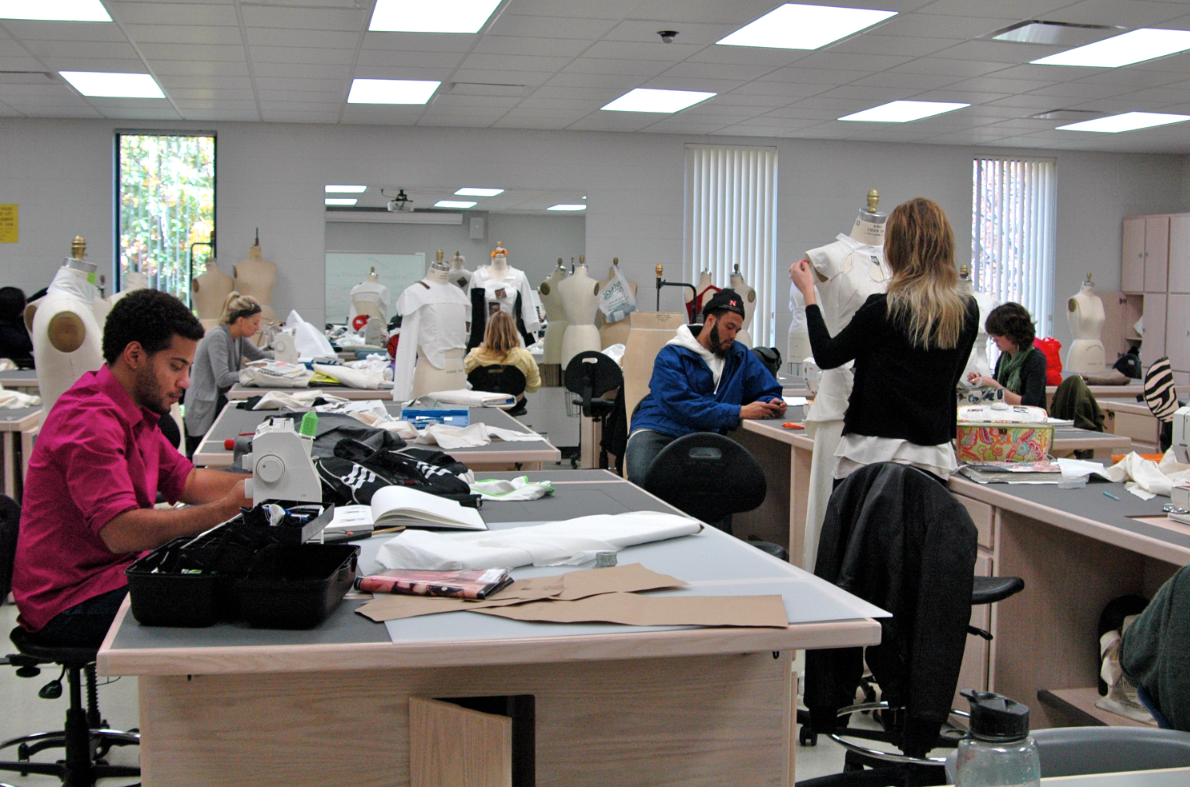
The apparel design studio of the textiles, clothing and design department underwent a series of renovations this summer that have been well received — and worn-in — by faculty and students.
“People pretty much got right to work, so the novelty wore off quite quickly,” said Michael James, Ardis James Professor of Textiles, Clothing and Design and department chair. “The renovations have created a good, positive energy that has perked up the entire atmosphere of the classroom.”
Students spent little time admiring the studio's space on the second floor of the Home Economics Building and a lot more time sewing.
“I was so thrilled to get in here and just start working because it’s so much bigger, brighter and cleaner,” said Julia Wang, a senior textiles, clothing and design major. “It’s more motivating to want to work.”
The studio updates include new lighting and seating, storage cabinets, ceiling and sink, ironing stations, and large wall coverings that double as pin-up surfaces for students to lay out designs and sketches.
Individual lockers are especially popular additions among students who now have a place to keep their belongings while they’re in the studio.
“The lockers are fantastic,” Wang said. “Before, we were sharing these little drawers that were maybe four inches deep and there was no way all of our stuff could fit in them.”
Two faculty offices were removed to enlarge the studio space. And, the studio features modified workstations that were designed based on faculty and student input.
Lincoln-based furniture company Contemporary Woods built a workstation prototype from a sketch provided by James. The sketch stemmed from a discussion with faculty and students.
“Space was a huge problem and so was organization,” Wang said. “It was really cluttered in here and it was hard to keep everything in order.”
Each workstation accommodates two students and is outfitted with retractable sewing machine mounts, drop leaves and fabric tube storage.
The workstations also boast new Bernina sewing machines that replaced the original machines.
“The old machines wouldn’t come out so easily and now these do,” said Kaela Knoll, a second-year textiles, clothing and design graduate student. “We’re not wasting time switching tables trying to find a machine that works.”
James said Contemporary Woods made sure the department got exactly what it envisioned in the quintessential workstation, even though the process involved some trial and error.
“They are great to work with because they come up with ideas and solutions that work nicely,” he said. “They brought the prototype into the department for faculty and students to test out for a period of about a week.”
The primary deficiency of the prototype was its exaggerated height.
“Not everyone is six feet tall,” James said. “We determined that it was too high, so they then went back and fabricated 12 new stations to the second set of specifications.”
The initial prototype is housed in the department’s basement studio, where it’s available for smaller class groups and students with special projects to use.
“The renovations are going to make a big difference in our ability to recruit new students because our old studio did nothing for recruitment,” James said. “It got to the point where I kind of cringed when I had to take parents of prospective students in there because it looked tired, worn out and used and abused.”
Knoll said that the fresh look of the studio would help bolster the department’s reputation as one of the most committed in the apparel design field.
“You don’t want to go to a school where you’re learning design but the building is super outdated,” she said. “The renovations are exciting for the department because they’re up to the standards of other colleges.”
The studio renovations are not the first to take place in the department — nor will they be the last.
In 2010, with support from the University of Nebraska Foundation and a group of donors, the Robert Hillestad Textiles Gallery was revamped with new carpet, lighting, paint, platforms and other improvements after being untouched for more than a decade.
“That was a case where the gallery had existed for close to 13 years and had not been renovated even though it’s heavily used and fairly heavily trafficked,” James said.
Within the next year, the department aims to renovate the external Textile Design Studio that’s located south of the Home Economics Building.
“It’s identified as the Textile Design Studio but it hasn’t been used that way in many, many years,” James said. “It’s basically storage space for the department. We are planning to convert it — we hope — within the next six months into a bio-fibers development laboratory to further research work that’s going on in the department in alternative fibers.”
Once that renovation is complete, the department plans to alter a double office space into a student-faculty research center that’s focused on entrepreneurship, with emphases on rural business development and e-commerce.
“We really want to tie those two together because any small business today needs to be conducting business online,” James said. “We have faculty doing research in this area and we have a whole vision for how it will look. It will give our merchandising students, who are the biggest part of our undergraduate student population, a place that’s a very visual focal point for them.”
James said that as funds become available, he will continue to spearhead renovations that push the program forward.
“We don’t want to look like we’re all about the past because that’s not what students are looking for,” he said. “It’s all about the future.”
— Mekita Rivas, University Communications